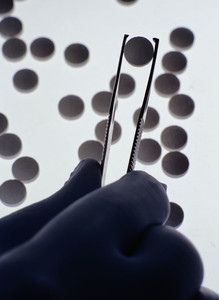The downside of having clear regulatory standards for approval of pharmaceuticals, according to Rodrigo Cristofoletti from Brazil’s Health Surveillance Agency (Agência Nacional de Vigilância Sanitária, ANVISA), is the overuse of one-size-fits-all (OSFA) approaches [1]. Although such approaches ensure harmonization throughout the regulatory decision-making process, they may not be adequate for all cases, and especially not in the case of complex generics.
During a 2006 Advisory Committee for Pharmaceutical Science meeting at the US Food and Drug Administration (FDA), the then current OSFA-based bioequivalence (BE) guidelines were declared to be Procrustean, i.e. taking no account of individual differences. However, Cristofoletti and colleagues point out that the regulatory paradigm in the realm of generics has advanced toward non-Procrustean approaches, for example, with the Biopharmaceutics Classification System-based biowaiver decisions, as well as reference-scaled average BE for highly variable drugs, keeping the pace with the modern era of individualized and precision medicine’.
The problem with complex generics is that demonstration of therapeutic equivalence remains a challenge, as recently stated by FDA Commissioner. FDA defines complex products as including products with complex active ingredients, formulations, routes of delivery or dosage forms; complex drug–device combination products; and other products where complexity or uncertainty concerning the approval pathway or possible alternative approach would benefit from early scientific engagement [2].
Complex routes of delivery, e.g.locally acting ophthalmic drugs
Due to the very low to undetectable levels of drug in the systemic circulation following the administration of ophthalmics, traditional average BE studies, focusing on systemic exposure metrics to compare test (T) and reference (R) formulations, is not adequate. In this case, FDA has recommended two alternative approaches: in vitro or in vivo patient studies.
Complex formulations, e.g. liposomes
In complex formulations, similar systemic exposure, in terms of total drug content, does not necessarily mean similarity in tissue exposure. The most challenging issue in demonstrating BE between complex formulations is to identify the most therapeutically relevant surrogate to bridge the gap between systemic exposure and target site disposition. Consequently, BE demonstration generally implies analysing the total and unbound or free and encapsulated drug concentrations. Additionally, comparison of in vitro particle/liposome size distribution using the population BE approach and demonstration of compositional equivalence are also recommended.
Complex drug substances, e.g. synthetic peptides and copolymers
With complex drug substances the main issue does not arise from BE assessment per se but from the demonstration of absence of differences between active pharmaceutical ingredients (API) by different manufacturers.
Glatiramer acetate is a classical representative of this category. While its formulation is rather simple (e.g. prefilled syringe containing 1 mL solution with 20 mg of glatiramer acetate and 40 mg of mannitol), showing the mixture of peptide copolymers is the same in T and R formulations is rather challenging. The state-of-art knowledge advocates applying the four-stage criteria focusing on demonstrations of: equivalence of fundamental reaction scheme; equivalence of physicochemical properties including compositions; equivalence of structural signatures for polymerization and depolymerization and equivalence of biological assay results. Even though this is a synthetic drug, regulatory criteria are similar to the head-to-head comparison currently used to evaluate biosimilars.
Complex drug–device combinations, e.g. metered-dose inhalers, dry powder inhalers or nasal sprays
The drug delivery characteristics of orally inhaled products (OIPs) are dependent on the respective device, which should be similar enough without infringing on the originator company’s patent. In the case of OIP, a considerable drug fraction is swallowed and acts as a confounding factor when using systemic exposure to infer about drug delivery and local lung deposition. Consequently, the traditional pharmacokinetic-based OSFA approach is not suitable to address the BE of OIP and a combination of in vitro, pharmacokinetic and pharmacodynamic studies are required.
Complex drugs are often high-cost medicines. They often face no market competition, even if their patent protection has already expired, due to the difficulties surrounding generics development. Therefore, the authors concluded that ‘developing scientifically sound, product-specific requirements is imperative’. They add that ‘using integrative approaches like the model-informed drug development, which includes PK/PD models, mechanistic absorption models, physiologically-based pharmacokinetic (PBPK) models, systems pharmacology and quantitative risk modelling) may be useful to improve drug development knowledge management and decision-making in a non-Procrustean way’.
Conflict of interest
The authors of the research paper [1] declared that there were no conflicts of interest.
Editor’s comment
Readers interested to learn more about complex generics are invited to visit www.gabi-journal.net to view the following manuscripts published in GaBI Journal:
Defining and characterizing non-biological complex drugs (NBCDs) – Is size enough? The case for liposomal doxorubicin generics (‘liposomal nanosimilars’) for injection
Ocular emulsions and dry eye: a case study of a non-biological complex drug product delivered to a complex organ to treat a complex disease
GaBI Journal is indexed in Embase, Scopus, Emerging Sources Citation Index and more.
Readers interested in contributing a research or perspective paper to GaBI Journal – an independent, peer reviewed academic journal – please send us your submission here.
Related articles
FDA issues guidance for developers of complex generics
Scientific and regulatory considerations for follow-on versions of complex drug products containing nanomaterials
References
1. Cristofoletti R, Schmidt S, Diniz A. Non-procrustean pathways for complex generic drugs development. Ther Deliv. 2018;9(9):605-7. doi:10.4155/tde-2018-0047.
2. GaBI Online - Generics and Biosimilars Initiative. FDA trying to reduce hurdles for complex generics [www.gabionline.net]. Mol, Belgium: Pro Pharma Communications International; [cited 2018 Nov 2]. Available from: www.gabionline.net/Generics/General/FDA-trying-to-reduce-hurdles-for-complex-generics
Permission granted to reproduce for personal and non-commercial use only. All other reproduction, copy or reprinting of all or part of any ‘Content’ found on this website is strictly prohibited without the prior consent of the publisher. Contact the publisher to obtain permission before redistributing.
Copyright – Unless otherwise stated all contents of this website are © 2018 Pro Pharma Communications International. All Rights Reserved.








 0
0











Post your comment